
Morganite vs. Diamond Rings: Pros and Cons of Morganite
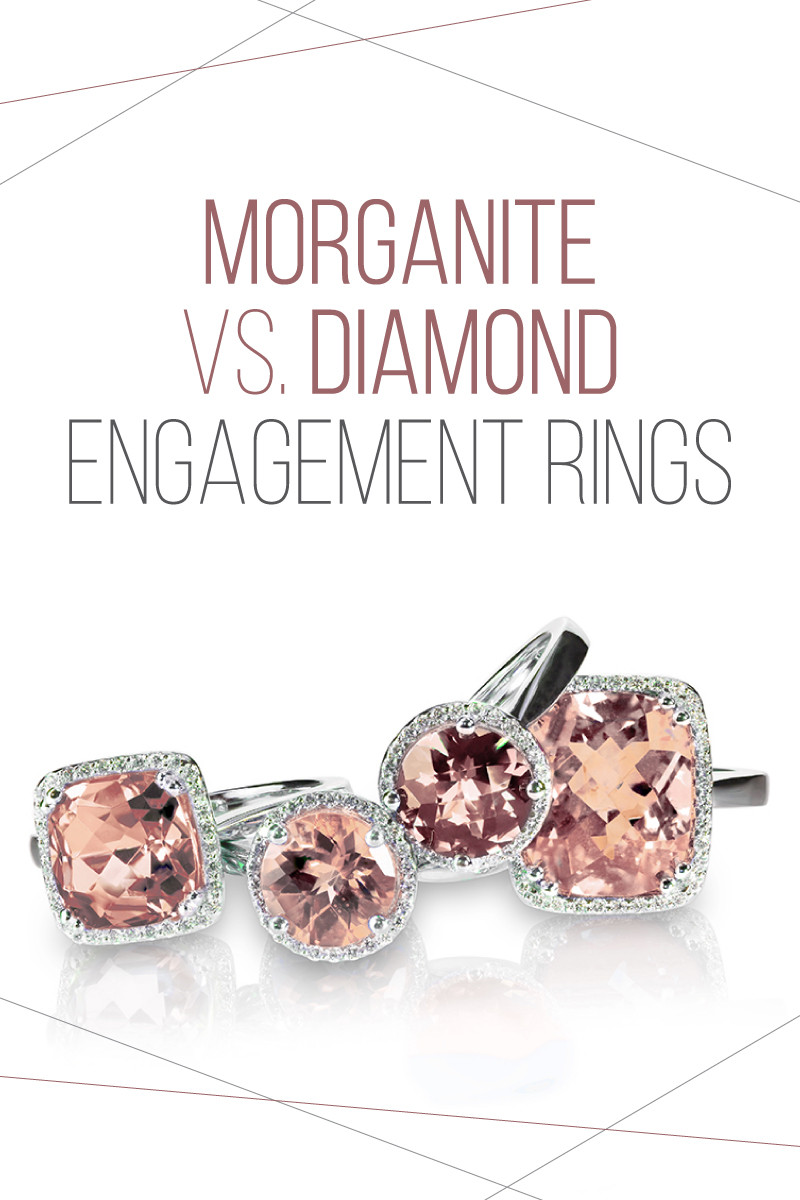 As more newlyweds opt for non-traditional engagement rings, gemstones like morganite have become popular diamond alternatives. Whether it’s for personalization, affordability, or adoration for the gemstone, the morganite engagement ring is here to stay.
As more newlyweds opt for non-traditional engagement rings, gemstones like morganite have become popular diamond alternatives. Whether it’s for personalization, affordability, or adoration for the gemstone, the morganite engagement ring is here to stay.
The classic diamond engagement ring has been a staple for the last century. Part of the appeal is their perceived rarity, but diamonds aren’t as rare as you’d think. In fact, the entire “tradition” of diamond engagement rings is the result of clever marketing started in the 1940s.
So, is morganite okay for an engagement ring? Absolutely! However, it’s best to do your research before shopping for any precious or semi-precious gemstone ring that you’ll wear for a lifetime.
Today, we’ll cover the pros and cons of a morganite ring vs. diamond ring. First, what should you know about morganite?
 Image: morganite gemstone
Image: morganite gemstone
What Is Morganite?
Morganite is a light ballet-pink to peachy-pink beryl gemstone, though some are purplish-pink. Trade names for this pink gemstone include “pink beryl,” “rose beryl,” or “cesian beryl.” Morganite’s name honors financier and gem collector, J.P. Morgan.
Some morganites are irradiated or heated for enhanced coloring, usually to remove orange or yellow undertones.
Is morganite a valuable gem? Yes and no. A colored gemstone’s value comes from multiple factors, including rarity, market demand, and of course, each stone’s quality.
Morganite is the rarest beryl variety apart from red beryl. Is morganite rarer than diamonds? Yes! In fact, based on mineral abundance, diamonds are more common than morganite.
Demand-wise, morganite hasn’t achieved diamond-level fame, so the gem isn't mined as often. Morganite’s popularity has gradually increased, though, so demand could change.
Remember that diamond marketing campaign we mentioned? Its basis was the slogan, “A Diamond is Forever.”
Is morganite forever? If you choose to wear it for your engagement ring, then absolutely! How long will a morganite ring last, and how does it stack up to diamonds? To answer that, let’s break down each gemstone’s durability.
 Image: white diamond ring
Image: white diamond ring
Comparing Durability: Morganite vs. Diamond Strength
Gemstone durability (or strength) comes down to four factors: hardness, toughness, cleavage, and stability.
Hardness is a stone’s relative scratch resistance. Diamond ranks at 10 on the Mohs mineral hardness scale, higher than morganite’s 7.5-8 ranking. But Morganite’s durability is nothing to scoff at. Remember that diamonds are the hardest gemstone in the world. Still, a 7.5-8 Mohs ranking is right up there with emerald, aquamarine, and topaz.
Toughness (or tenacity) is a gem’s resistance to breaking or bending from a hard blow. Morganite and diamond are brittle, meaning an extremely hard blow could shatter either.
However, diamonds have perfect cleavage in four directions, meaning a hit from any of these angles will split or smash the diamond. Morganite has poor cleavage in 1 direction, so it’s harder to split.
What about stability? Extreme heat can make morganite’s color fade, while extreme temperature changes can make diamonds fracture. With diamond and morganite (treated or not), light exposure won’t cause damage.
Diamonds don’t react with any chemicals, but morganite’s composition will change with exposure to hydrofluoric acid and solvents.
 Image: pink morganite ring
Image: pink morganite ring
Other Durability Factors
Part of the equation for gem longevity is practicing proper cleaning and storage methods for your ring. But, choosing the right cut and setting is equally important. It can be the difference between a pristine family heirloom and a chipped disappointment.
Pointed edges on faceted cuts — e.g. princess, trillion, and marquise — can chip if hit. Thin girdles (the perimeter around the crown) also risk chipping, usually seen on princess, emerald, or marquise cuts.
However, you can choose a somewhat vulnerable cut and still keep your gem safe with the right protective setting.
Bezel or V-shaped claw settings keep the gem safe and secure. For prong settings, more prongs (six prongs instead of four) will provide better protection. Cathedral and tension settings can put your stone at higher risk of damage.
Overall Advice: The safest cut is one with rounded edges and sides, like oval, round brilliant, or cushion cuts. If you opt for a more vulnerable cut, pair it with a protective setting like a bezel, v-shaped claw, or 6-prong cradle.
While longevity is important for engagement rings, so is flaunting that gorgeous rock! Next, we’ll break down how morganite and diamond compare visually.
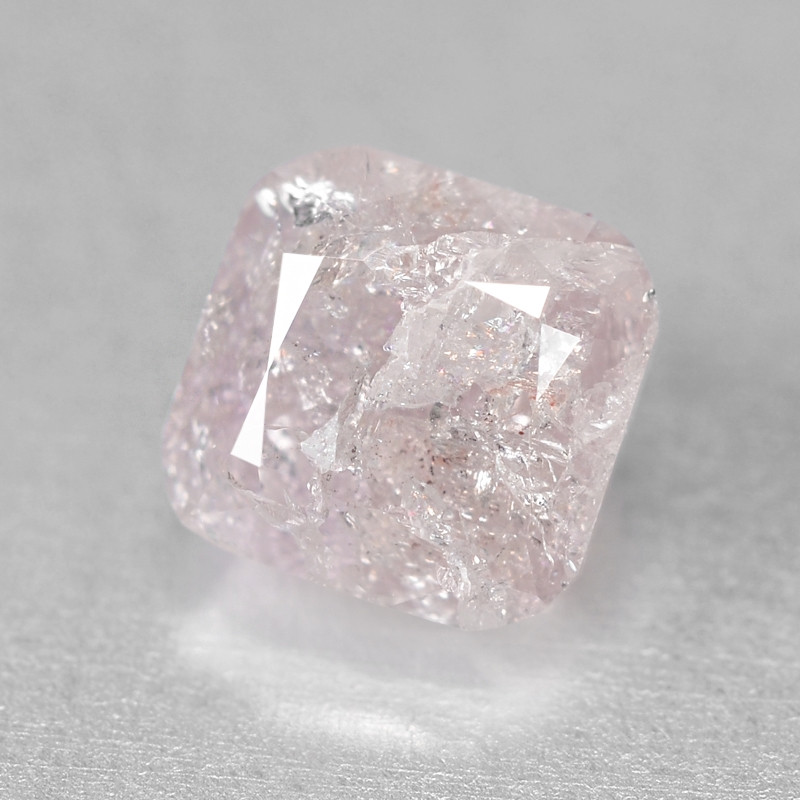 Image: pink diamond
Image: pink diamond
Morganite Vs. Diamond: Comparing Appearance
Part of morganite’s appeal is its subtle, romantic coloring, while part of diamond’s appeal is its signature sparkle. Each stone’s appearance covers multiple factors, though, so let’s examine each one.
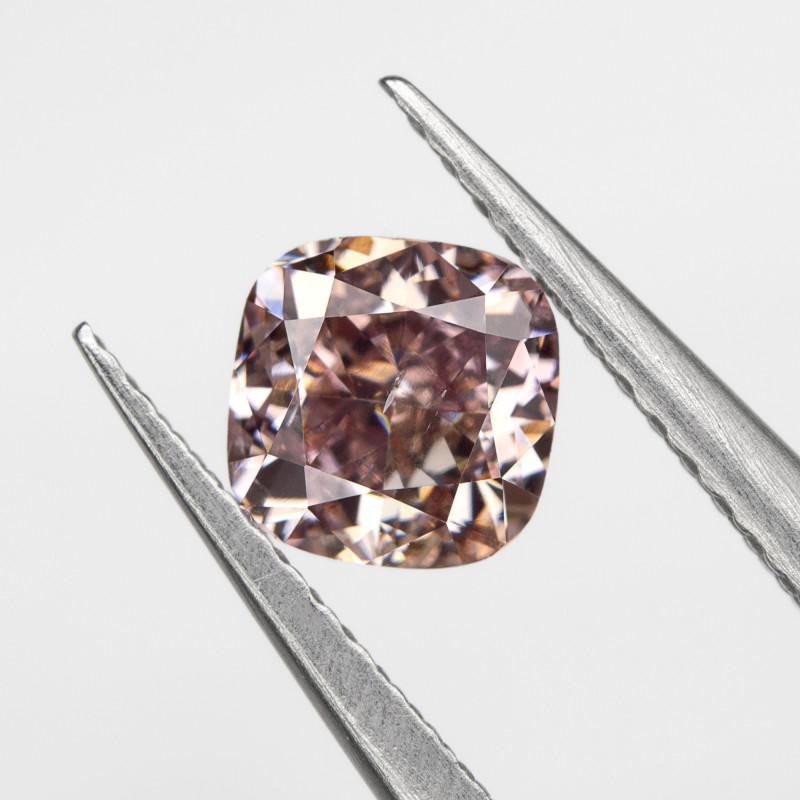 Image: brownish-pink diamond
Image: brownish-pink diamond
 Image: peachy-pink morganite
Image: peachy-pink morganite
Color
If you’re after a colorless gemstone, white diamonds are easy winners. But, pale pinkish-white morganite engagement ring stones offer dimension and lower prices, even lower than most morganite.
Comparing pink diamond vs. morganite, both stones come in light pink, peachy-pink, violet-pink, and pinkish-orange hues. However, pink diamonds have a wider range of intensity and hues.
Morganite stones are almost always pale, though they’re often treated to enhance their saturation. Still, even the most intense morganite colors won’t be as deep as pink diamond’s colors.
Of course, color intensity can change based on the stone’s clarity.
 Image: pink diamond with I (Included) clarity grade
Image: pink diamond with I (Included) clarity grade
 Image: morganite with type I clarity
Image: morganite with type I clarity
Clarity
Clarity measures the presence of inclusions inside a gemstone. Diamond clarity grades are more specific and extensive than colored gemstone clarity grades.
Morganite is a Type-I clarity gemstone, meaning it’s almost always found without visible inclusions. Therefore, it beats out diamond in terms of consistency, since diamond clarity varies widely from one stone to the next.
Do morganite rings get cloudy, though? Morganite won't naturally fade or get cloudy over time — only when it needs to be cleaned. Once it’s cleaned, your morganite will be clear and shiny like new!
Speaking of shine, does morganite sparkle like a diamond?
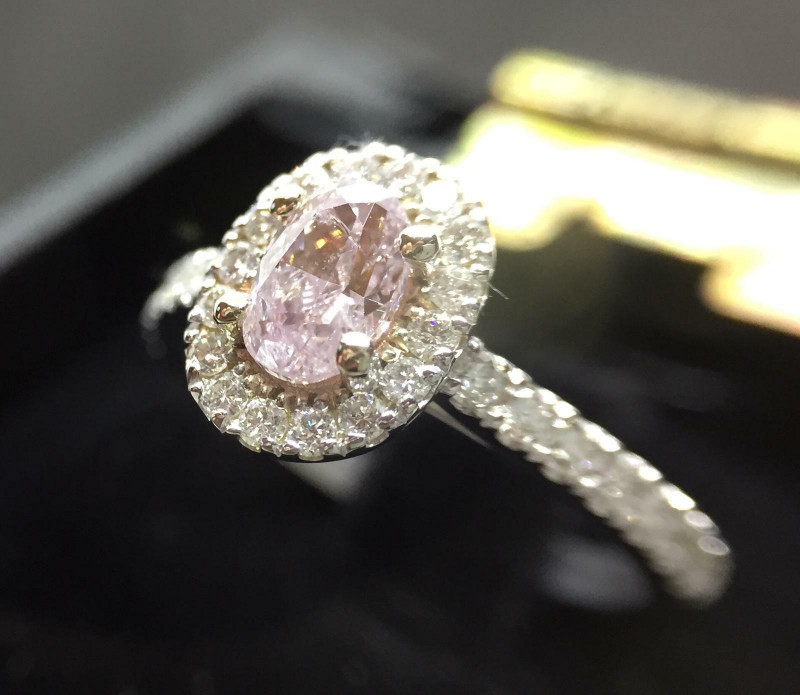 Image: pink diamond ring
Image: pink diamond ring
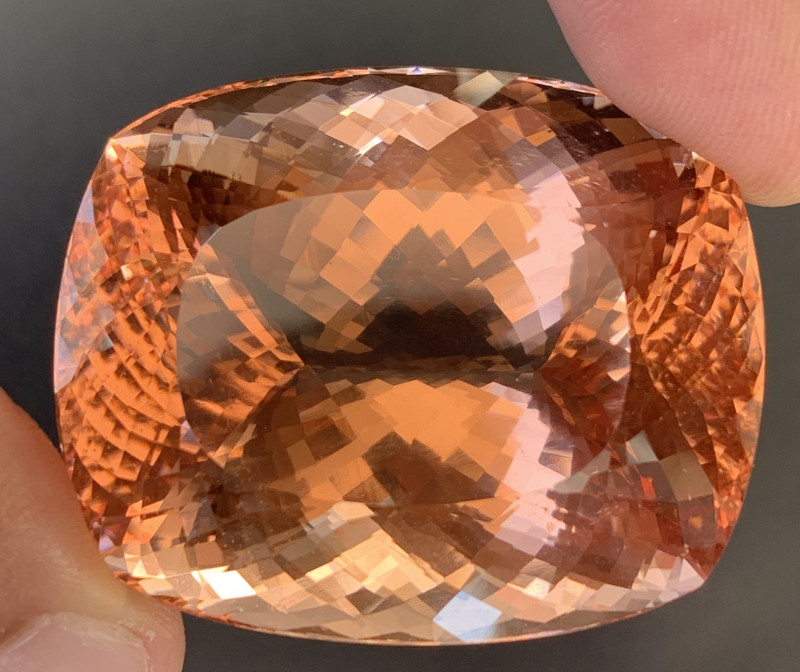 Image: morganite gemstone
Image: morganite gemstone
Brilliance & Fire
We all love a good sparkle, which is all about light reflection. In gemstones, sparkling light reflection comes down to brilliance and fire.
Brilliance describes how much white light reflects from the crystal’s interior. A higher refractive index means greater brilliance. Morganite’s refractive index is 1.57-1.60, while diamond’s is 2.41-2.42. Therefore, diamonds are over 60% more brilliant than morganite.
Fire, or dispersion, refers to colored light reflections that appear “active” like flickering flames. Diamond‘s fire (0.044) outranks morganite’s fire (0.014) by over 30 percent.
There’s one sparkling trait where morganite pulls ahead: birefringence.
While brilliance and fire describe the color of reflected light, birefringence describes multiple rays of light reflecting in different directions. Gemstones must have two refractive index measurements (double-refraction) to be birefringent.
Birefringent gems can display unique visual effects like pleochroism, where you’ll see different colors on the stone from different viewing angles. Morganite has strong pleochroism in light pink to deep bluish-pink. Diamond doesn’t have birefringence or pleochroism.
As you can see, both stones are beautiful. But a major decision factor is price. How much is a morganite ring worth versus a diamond ring?
 Image: morganite and diamond jewelry set
Image: morganite and diamond jewelry set
Morganite vs. Diamond Price
Starting with the million-dollar question: Is morganite cheaper than diamond? Yes! The lower morganite ring cost is a major selling point for budget-savvy buyers.
Generally, the white diamond price per carat is 10-times more expensive than morganite price per carat. Moreover, pink diamonds can cost as much as 20-times more than white diamonds. That means pink diamonds can be 200-times more expensive than morganite!
In actual numbers, pink diamonds range from around $10,000-$700,000 per carat, mostly depending on color saturation. White diamonds change in price depending on carat weight.
A 1-carat white diamond with good clarity in a round brilliant cut can range from $2,000 to $25,000 per carat, whereas 0.5-carat options are $1,200-$5,800 per carat.
Most newlyweds opt for 1-carat stones, so how much does a 1-carat morganite cost?
Ignoring the other factors of a morganite ring like metal material or cut, most 1-carat morganite gemstones are $100-$300 per carat. Larger carat weight like 2.5-carat or 4-carat options are typically $800-$1,800 per carat. Plus, morganite comes in larger carat weight options than diamond. With morganite, you can flaunt a larger rock at a fraction of the price of a smaller diamond.
Despite morganite’s rarity and recent rise in popularity, most people still don’t know about it. So, is morganite a good investment? Definitely! As its popularity and subsequent demand grows, morganite will likely rise in price, so it’s a perfect time to invest in a new or vintage morganite ring.
Besides financial investments, many of us want to invest in a better future by opting for sustainable sourcing and ethical labor practices when we can.
 Image: pink morganite rough
Image: pink morganite rough
Ethical Concerns and Sustainability
Ever since the captivating 2006 docu-series Blood Diamonds brought unethically sourced “conflict diamonds” into public awareness, many buyers have concerns about where and how their diamonds are mined.
Luckily, the Kimberley Process Certification Scheme began in 2000, an international effort to keep diamond trade accountable and conflict-free. In Australia, anyone who wants to export diamonds must prove their sourcing was ethical and legitimate with a Kimberley Process Certificate.
Diamonds labeled “conflict-free” or “ethical” have been mined sustainably, with safe and fair treatment of miners.
In general, diamond mines are larger-scale, while colored gemstones mines are smaller-scale. While larger-scale mines tend to have bigger ethical issues, it’s easier to hold them accountable publicly than it is to keep tabs on small-scale operations.
While unethical morganites don't have the same history as blood diamonds, many gemstones can be considered “conflict” stones.
How Do You Buy Ethically Sourced Gems?
Luckily, experts can often estimate a colored gemstone’s nation of origin based on geological clues. Like a diamond certification, reports from reputable, long-serving labs can include an expert opinion on a colored gem’s origin, like the GIA Colored Stone Identification and Origin Report.
In fact, an official gemstone certification for your morganite can tell you not only if it’s natural, but also if it potentially came from a conflict source. Unfortunately, origin-tracing doesn’t apply to diamonds the way it does for colored stones like morganite.
To ensure your diamond came from ethical sources, look for: a Kimberley Process certification, records on labor conditions, statements on the mine’s sustainability efforts, and supply-chain documentation. We still recommend getting your diamond certified (or asking for the certification before you buy) to ensure it formed naturally and matches the quality being advertised.
Environmentally, the most sustainable choice is an antique or up-cycled ring. By choosing vintage morganite engagement rings, you’re helping reduce waste and getting a jewel with its own fascinating history!
 Image: pink diamond ring
Image: pink diamond ring
Diamond and Morganite Engagement Ring Meaning
Many couples are drawn to diamonds for what they represent: unbreakable, everlasting love. Diamond’s root word, adamas, even means “invincible.”
Diamonds are also a symbol of status and have been for centuries. Many couples believe investing in one represents their commitment, literally and figuratively.
But what does a morganite engagement ring mean?
Morganite is nicknamed the “Stone of Divine Love.” Its soft peach or pink hues evoke tenderness and sweet romance. Beryl stones represent respect and fidelity, and morganite spiritual meaning adds in patience and compassion.
For those recovering from painful romantic experiences, morganite is especially meaningful. The crystal is said to heal deep emotional wounds and reassure you of your worthiness for true, compassionate love.
Outside of spiritual meanings, a statement morganite ring can represent your unique style, relationship, and willingness to not conform to the status quo.
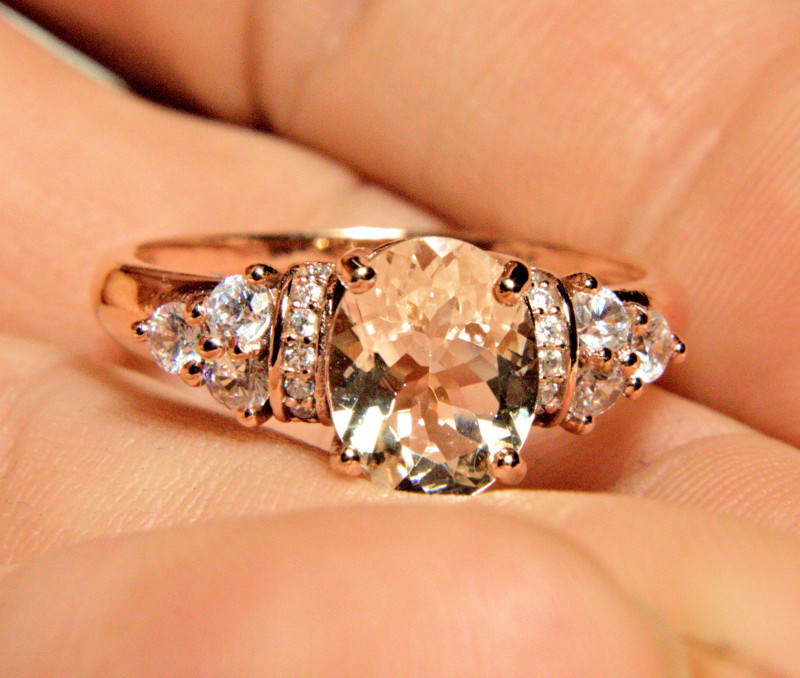 Image: morganite ring with accent diamonds
Image: morganite ring with accent diamonds
Wrapping Up: Is A Diamond Better Than Morganite?
Now that you have all the background knowledge you need, it’s up to you: Is morganite a good stone for an engagement ring?
If brilliance or status is your top priority, white or pink diamond is probably for you. If you’re after a unique color and style at a much lower price point, morganite rings are a durable, beautiful option. Can’t decide? Opt for a morganite engagement ring set with accent diamonds!
Still on the fence? Browse our morganite and diamond gemstone collections to find your forever gemstone!
Search the Gemstone Encyclopedia
Related Auctions
Related Articles
Azotic treatment of Topaz and Quartz is a treatment that creates a layer of color over a gemstone. Learn more about this treatment and check out our stones fro sale.
8th May 2018
There are dozens of quartz and chalcedony gems with various colors and patterns. Learn all about quartz properties and every type of quartz, from amethyst and agate to plasma and phantom quartz!
15th Oct 2020
Quartz and Topaz are two of the most common minerals on the planet. They also look very similar. Let's look at some properties of them and compare Quartz and Topaz.
23rd Oct 2018
Latest Articles
Friedelite is an uncommon pink, red, or brown manganese silicate mineral best known from New Jersey and South Africa. Learn the prices, properties, uses, and history of friedelite gemstones.
23rd Dec 2024
Shortite is a rare mineral and rarer gemstone, usually found as colorless or yellow wedge-shaped crystals. Learn the value, history, and properties of shortite in this guide!
9th Dec 2024
Senarmontite is an uncommon antimony mineral mostly used industrially but occasionally collected as rare gems or pearly crystals. Find out all of the traits, uses, prices, and history of senarmontite.
27th Nov 2024
Article Categories
How To's is where you will find helpful articles from gem Rock Auctions on how to cut gemstones, select gemstones and buy gemstones.
9 Articles







